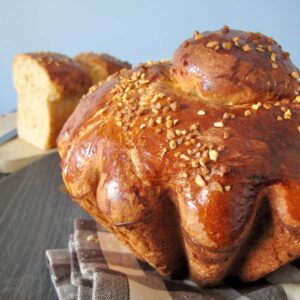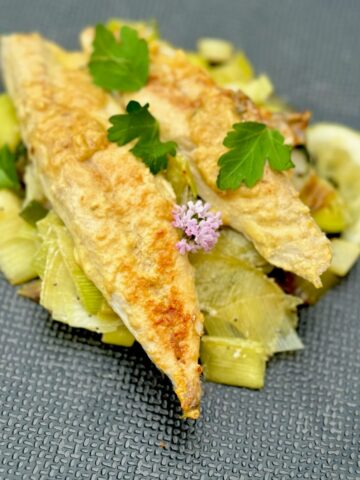How to make fluffy French brioche. Discover how to make your brioche rise - with ideas for fillings and toppings using our family's best recipe.

What is Brioche Made of?
Like bread, brioche is also made with yeast but is much lighter and airy. As it's made with eggs, butter, milk and a little sugar, brioche is also slightly sweeter than regular bread.
The fluffy texture inside is very different to bread and the outside crust is glazed with egg yolk, making it shiny and slightly crispy.
Why is Brioche so Expensive in Bakeries?
Brioche tends to be quite expensive in bakeries for two main reasons.
- It simply takes a lot more time to make;
- There are many more ingredients than regular bread such as the butter and eggs.
It's for this reason that it's seen as a pastry rather than bread and falls under the umbrella name of viennoiseries.

French Brioche
Can you imagine living in a street called Brioche lane?
I'd personally feel compelled to have brioche dough out on the window ledge, puffing up proudly for the tourists that passed (that's the dough not me), inviting everyone to have a part in making it! I snapped this French street sign as we were meandering on our walk in Rhône wine country.
However, it perhaps should read in the plural, Impasse des Brioches, as there are many kinds in France.
Different Kinds of French Brioche
There are so many different kinds of brioche in France. There are at least 30 variations of Brioche around France, as every region has pretty much its own version.
- In Lyon, bakers add pink pralines (see my article on pastries in Lyon), very similar to the Savoyard speciality, le Saint-Genix.
- Head north for the Cramique with more sugar, chocolate or raisins - to taste this, visit Aux Merveilleux de Fred in Paris, one of their main specialities.
- Then there's the special Kouglof or Kügelhopf variation of Brioche from Alsace, with added nuts, raisins and glazed with a syrup.
- In the Vendée region around La Rochelle is the Gâche and in the Aveyron, the Fouace - shaped like a crown.
- Around Epiphany, in French bakeries we see la Brioche Couronne or Brioche des rois - a speciality of the south of France. It's also shaped in a ring to resemble a crown, studded with candied fruit jewels and a hidden fève or trinket inside. It's the brioche version of the classic Galette des Rois (French King Cake).

Parisian and Nanterre Brioche
Perhaps the most recognised around Paris is the Brioche à Tête, also known as the Brioche Parisienne (Parisian Brioche).
The Parisian brioche is basically a large ball with a little head on top, hence its name. As we live in Paris, I'm showing you how to make both this version which needs a special brioche tin - plus the easier Brioche Nanterre, as it can easily be made using a regular cake or loaf tin.
Likewise, I'm cheating a bit, as we love the famous Pogne de Romans, found in the Drome region for its touch of orange blossom. So I'm adding this to the dough to give you an idea of its beautiful flavours. Otherwise it's not used in a classic Parisian version. If not using, just replace the orange blossom water with more milk or just water.
How to Make Brioche Rise
The golden rule with brioche is take your time. It's so simple to make - but if you're in a rush, forget it.
From experience, I wouldn't recommend you make this while you're multi-tasking. When I've been rushing back from Mum the taxi or grocery shopping, many times I'd completely forgotten the dough rising in all its glory 2 hours later. I also did this when my friend, Christina came to stay. I'd discovered brioche dough oozing down the side of a radiator or above the oven sticking to the door. Hence my previous title to this recipe: Arise, Sir Brioche!
So, Sir Brioche prefers to be treated with more respect and not just fitted in to a last-minute schedule.

Brioche Nanterre - Loaf Made with 3 Dough Balls
Depending on your mood, you can add all sorts of sweet surprises (see step 4).
This is the part that the kids love to join in and create their own combinations; especially claiming their own brioche 'ball'. Additions make this less classic but the kids have adored chocolate chips, walnuts, pistachios, cranberries, orange peel, or soaked sultana raisins (either steeped in more orange flower water or Earl Grey tea). The list is endless, so it's great to keep changing the brioche ball game.
French Brioche Recipe
The first rule is to take your time. The other golden brioche rule is to ensure your ingredients are at room temperature. The rest is a piece of brioche.
I make brioche using a stand mixer, but I used to make it just as well by hand (but takes much longer!). This recipe originally came from the French Alsa Briochin® dried yeast packet instructions. I like it as it uses many eggs and more milk than the average recipe. Over the years, I've adapted it with less butter, less sugar and our favourite addition is the orange flower water.
The brioche also freezes well for up to a month.
How to Make a French Brioche
- Mix the flour, salt, sugar and dried yeast in an electric mixing bowl and make a well. Attach the dough hook and start mixing on the lowest setting.
- Add the warmed milk, orange flower water and then the eggs one by one and mix well until you have an even dough. Gradually add the melted butter (leave a bit to butter the brioche tin if it's not silicone), mixing for at least 20 minutes until the dough doesn't stick to the sides of the bowl.
- Cover with a clean dish-towel and leave to rise in a warm place (24-35°C) for an hour until it looks like this.

- Knock down the dough (if you're adding chocolate chips, nuts, or candied fruits, mix these in). If making a brioche à tête, rip off a small amount of dough (size of a ping-pong ball). Roll and stretch the dough into one large ball and place in a fluted brioche tin. Create a tiny well at the top middle and roll on the little pingpong dough head on top.
- If making a brioche loaf (brioche Nanterre), divide the dough into 3 and roll into 3 tennis-sized balls and place in a cake or loaf tin.
- Leave again in a warm place for another hour until the dough rises to at least double its size.
Separate the eggs for the yolk glaze. Place the whites in a clean jar, cover and keep aside in the fridge (or freeze) for up to 5 days (make financiers or tuiles with them - or macarons from my books!). - Preheat the oven to 180°C/160°C fan/350°F/Gas 4. Brush the brioche with egg yolks mixed with a bit of water to glaze and sprinkle with pearl sugar (or 3 crushed sugar lumps).
Bake in the oven for 25-30 minutes until golden. If the brioche browns too much, cover with greaseproof paper halfway through baking (although we prefer it browned, just how they serve it in our local boulangerie.) - Cool the brioche on a wire rack. Let the brioche rest for about an hour before devouring; straight from the oven and it will be too yeasty.
What to Serve with Brioche
Sometime plain is best, just with the traditional pearl sugar (or crushed sugar lumps) or a toasted nutty topping. If using the orange blossom, it's beautiful on its own to appreciate these subtle flavours.
As Brioche has a little amount of sugar, it's good with honey or jam, such as recipes for:
- apricot and lavender jam,
- fig jam (reduced sugar with orange)
- spiced plum or
- rhubarb and rose.
- Alternatively, serve with homemade rhubarb or strawberry compote.
What kind of goodies would you hide inside or sprinkle on top of your brioche? Or do you prefer it 'plain' with orange blossom?

Fluffy French Brioche
Ingredients
- 500 g (18oz/ 4¼ cups) plain flour (all-purpose)
- 50 g (2oz/ ¼ cup) caster sugar
- 1 teaspoon salt
- 12 g dried baker yeast (2 sachets/envelopes)
- 100 ml (7tbsp) whole milk warmed
- 2 tablespoon orange blossom water (if not using, replace with more milk)
- 4 large eggs organic
- 150 g (5½oz/ 1 stick + 2 tbsp) unsalted butter melted
- 2 egg yolks (to glaze)
- 1 tablespoon pearl sugar (or 3 crushed sugar lumps) to decorate
Instructions
- Mix the flour, salt, sugar and dried yeast in an electric mixing bowl and make a well. Attach the dough hook and start mixing on the lowest setting.
- Add the warmed milk, orange flower water and gradually the eggs, one by one. Mix well until you have an even dough. Gradually add the melted butter (leave a bit to butter the brioche tin). Mix for at least 20 minutes until the dough comes away from the sides of the bowl and loses its stick.
- Cover with a clean dish-towel and leave to rise in a warm place (24-35°C) for an hour until at least doubled in size.
- Knock down the dough (if you're adding chocolate chips, nuts, or candied fruits, mix these in). If making a brioche à tête, rip off a small amount of dough (size of a pingpong ball). Roll and stretch the dough into one large ball and place in a fluted brioche tin. Create a tiny well at the top middle and roll on the little head on top.If making a brioche loaf (brioche Nanterre), divide the dough into 3 and roll into 3 tennis-sized balls and place in a cake tin.Sprinkle with the pearl sugar or toppings of your choice.
- Leave again in a warm place for another hour until the dough rises to the top.Separate the eggs for the yolk glaze. Place the whites in a clean jar, cover and keep aside in the fridge (or freeze) for up to 5 days. SEE NOTES
- Preheat the oven to 180°C/160°C fan/350°F/Gas 4. Brush the brioche with egg yolks mixed with a bit of water to glaze. Bake in the oven for 25-30 minutes or until golden brown. If the brioche browns too much, cover with greaseproof paper halfway through baking (although we prefer it browned, just how they serve it in our local boulangerie.)
- Leave the brioche to cool on a wire rack.
Notes
This post was first published 12 September 2012 but has now been updated with a printable recipe card.














Thomasina
I love brioche and at last I've found a super recipe to make it all by myself when no one is around so I can concentrate.
Jill Colonna
Love that - you're like me, Thomasina. This is a delicious yoga with a brioche at the end!
Christina
I absolutely LOVE brioche, whether French or Italian! I think they're pretty much the same, right? Oh what I'd do for one of these right now! Did you know in Sicily they dip them into granita topped with cream!?
Jill Colonna
That's a really interesting question, Christina. I've just looked it up and according to Anna Maréchal in my French book, 'On va déguster l'Italie', the Italian brioche was inspired by the French with it's yeasted dough of flour, butter, egg and sugar. It's often round - and known as col tuppo in Sicily. I remember you telling us about them on Insta being dipped into granita in Sicily. That sounds so lovely!
Hester @ Alchemy in the Kitchen
Jill, sounds like Brioche is the perfect antidote to the hustle and bustle of NY. The orange flower water kicks it up a notch.
p.s. I want that street sign for my house! Is there a Rue des Macarons?
Parsley Sage
Every weekend!? You get to have this every stinking weekend!? Dude...CK is lucky if I break out the waffle mix on a Sunday morning. You're raising the bar, my dear. This brioche looks PHENOMENAL 🙂
Jill
MOST weekends. Isn't that terrible? I love this so much and to be honest, Carsley, I don't like paying a fortune for a wee brioche in the boulangeries when we can have our own fillings at home. Not raising any bar, just the dough! 🙂 Thanks for popping by.
Nami | Just One Cookbook
How WONDERFUL! I want to eat this every weekend! What? Of course I do not mind eating macarons all the time! Especially if you make them for me! 🙂 If my Brioche dough rise like yours, I think I'd be addicted to baking. I've never succeed on rising part. Gotta learn and practice... 🙂
Jill
Give this one a try, Nami - the other secret is at Step 3: ensure that the warm place to let the dough rise is between 24-35°C and you'll see it puffs easily and the aroma grows too! Why don't you make a Matcha green tea version? Now there's an idea...
Grubarazzi (@Grubarazzi)
What an absolutely perfect brioche recipe. I can't wait to try this! On a day I can give it due respect, of course 🙂
Jill
I can swear by this recipe since I make it so often and it never let's me down. Enjoy it!
Amelia Schmelzer
I would love to live on any street named after a baked good/pastry! Your recipe looks fab--can't wait to try it. 🙂
Jill
Isn't it fun, Amelia? Hope you get to try it - no doubt you'll make it into clever jewellery of yours!
Kim - Liv Life
Ahhh, how I love Brioche!! I haven't made it in quite some time, however when I do the kids gobble it up in no time. My son has discovered his love of jam, and on our vacation last summer had a real brioche with strawberry jam. His new love! I will have to surprise them one of these days. Thanks for this recipe!
Jill
There's nothing more precious than surprising kids, eh? Love it when their faces just light up so hope you can make this soon with his favourite jam, Kim.
Lora
Wow I can smell how delicious this is from across an ocean.
Jill
So the scratch and sniff application works, Lora?